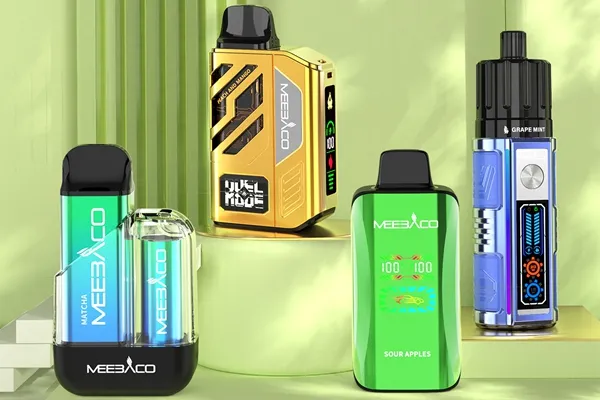Industry Updates
You can master the latest information, new product , exhibition, promotion, etc
WARNING: This product contains nicotine. Nicotine is an addictive chemical.
This product is not intended for minors, non-smokers, or individuals under local age restrictions.
The products displayed on the MEEBACO website are intended for the international market.
Due to regulations, available products for different regions may vary. Thank you for your understanding.
Release time:2025-06-03 16:59:37Views:
The global e-cigarette market remains dynamic and complex, driven by evolving regulations, technological advancements, and shifting consumer preferences. For businesses sourcing and exporting e-cigarettes, staying ahead of the curve is crucial. Here's an in-depth look at the key trends poised to shape the industry in 2025:
1. Regulatory Tightening & Standardization:
The global regulatory landscape will continue to mature and fragment. While the EU's Tobacco Products Directive (TPD) and the US FDA's Premarket Tobacco Product Applications (PMTAs) set benchmarks, other regions (Asia-Pacific, Middle East, Latin America) are actively developing or strengthening their own frameworks.
Impact: Expect stricter controls on marketing (especially to youth), nicotine concentration caps, flavor restrictions (particularly appealing flavors), enhanced product safety and quality standards, and more rigorous manufacturing compliance (GMP). B2B buyers must prioritize suppliers with demonstrable compliance capabilities across key export markets. Traceability requirements might increase.
2. Technological Sophistication (Beyond Cloud Chasing):
Smart Features & Connectivity: While basic Bluetooth connectivity has existed, 2025 will see wider adoption of companion apps for features like puff tracking, battery management, device locking, personalized settings, coil resistance monitoring, and potentially nicotine intake estimation.
Performance Optimization: Advancements will focus on enhancing core user experience: longer-lasting batteries with faster charging (USB-C becomes standard, wireless charging grows), improved coil longevity and flavor delivery, more effective leak resistance technology, and more precise temperature control. Integration of basic AI for adaptive experiences might emerge.
Material & Design Innovation: Continued exploration of alternative materials (enhanced plastics, composites, eco-materials) for durability and aesthetics. Emphasis on ergonomic design and ease of use.
3. Heightened Focus on Health & Harm Reduction:
While harm reduction compared to smoking remains the core argument, consumer demand and regulatory pressure will drive innovation focused on reducing potential risks.
Refined Technology: Optimizations targeting lower temperature vaping (potentially reducing carbonyl formation) and minimizing dry hits will be marketed.
Transparency: Demand for clearer ingredient disclosure and third-party lab testing results (for e-liquid contents and aerosol emissions) will grow among discerning consumers, pushing suppliers to provide this data. Pharmaceutical-grade nicotine sourcing becomes a key selling point.
4. The Evolution (Not Extinction) of Disposables:
Despite environmental and regulatory scrutiny, disposables will remain significant due to convenience and accessibility. However, significant changes are coming:
Capacity & Compliance: Increased puff counts (moving from 600 to 1000, 1500, 2000+) within existing nicotine limits per device (leading to larger devices or lower nic concentrations). Regional nicotine limits will dictate strategy.
Sustainability Push: Pressure for eco-solutions will intensify. Expect growth in (truly) rechargeable disposables (with USB-C), increased use of recyclable materials (though collection infrastructure lags), and potentially innovative collection/recycling schemes led by brands or retailers. Biodegradable options remain challenging but R&D will continue.
Flavor Adaptation: Restrictions on non-tobacco flavors in key markets (like some proposed EU rules) will force disposables to focus more on tobacco, mint/menthol profiles, or simpler fruit profiles where allowed. "Lost Mary" style convenience dominates, but niche brands may offer complexity.

5. The Resilient Rise of Open Systems & Refillable Pods:
Fueled by cost-effectiveness, customization, and environmental concerns compared to disposables, open systems (pod mods, tanks) will see significant growth, especially in mature markets and among committed vapers.
User-Centric Design: Continued improvements in pod sealing to eliminate leaks, easier coil/pod replacement mechanisms, and enhanced airflow controls.
Performance Pods: Refillable pod systems will increasingly blur the line with sub-ohm tanks, offering higher power options and improved coil technology for better flavor and vapor production within a pod format.
Salt Nic Remains King: Nicotine salts will continue to dominate the open pod market due to smoothness and higher strengths, but freebase options will retain a foothold.
6. Flavor Exploration & Sensory Experience:
While regulations threaten flavors, innovation will continue where possible:
Complexity & Nuance: Development of more sophisticated, layered flavor profiles that evolve during the vaping experience, moving beyond overly sweet single notes.
Novelty & Regional Tastes: Introduction of unique flavor combinations and continued focus on regional preferences (e.g., specific fruit profiles popular in Asia, dessert flavors in Europe).
Enhanced Ingredients: Exploration of natural flavor extracts and organic formulations, although cost and stability are hurdles.
7. Sustainability Moves from Buzzword to Business Imperative:
Environmental impact (battery waste, plastics) is a top criticism of the industry. Expect serious action:
Design for Disassembly: Easier separation of components (battery, plastic, metal) for recycling.
Recycled Materials: Increased use of post-consumer recycled plastics (rPET, rPP) in packaging and potentially device bodies (where structural integrity allows).
Supply Chain Transparency: B2B buyers will increasingly scrutinize suppliers' environmental policies, carbon footprint, and labor practices. Certifications could become a differentiator.
Rechargeable Focus: The shift towards rechargeable systems is partly driven by sustainability.
Conclusion for Global Suppliers:
2025 presents both challenges and opportunities in the e-cigarette market. Success will depend on agility, strict regulatory adherence, continuous technological innovation (especially smart features, battery life, leak prevention, and sustainable solutions), and a deep understanding of diverging regional demands. Disposables will adapt (larger capacities, rechargeable options), while open systems will gain ground. Prioritizing supply chain transparency, robust compliance documentation, and tangible steps towards sustainability will be essential for attracting discerning B2B partners and navigating the increasingly complex global landscape. Manufacturers who can combine cutting-edge technology with regulatory rigor and environmental responsibility will lead the next wave of growth.